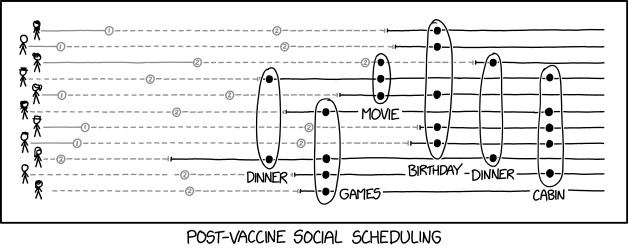Post Vaccine Social Scheduling

As if these problems weren't NP-hard enough.

As if these problems weren't NP-hard enough.
This comic is another in a series of comics related to the COVID-19 pandemic, specifically regarding the COVID-19 vaccine.
The comic shows a timeline of a multitude of (presumably) friends and acquaintances getting two doses of the SARS-CoV-2 vaccine. Due to the recommended delay between shots, as well as the few weeks needed to build antibodies after the second shot, planning get-togethers becomes complicated by who is free to meet, or not yet.
The diagram is some form of Scheduling Diagram, maybe akin to a Gantt chart, which helps to coordinate the status of several individual 'processes' (personal vaccination schedules) and demonstrate where dependent activities (meet-ups) are mutually possible.
Eventually, everyone can start getting together, but during the time where some people have only received one, neither, or only got the second recently, the scheduling is complicated. The complication is increased by the fact that people who have received one or two doses of vaccine, but haven't gone through the whole waiting period, can be expected to have some protection, but possibly not full protection (as represented by the dashed line). In that case, there's the added question of how important it is that the person is at an event, and how much risk the people involved are willing to tolerate. This may be the reason for the "movie" set, in which all participants will have received both doses, but one will not have completed the final waiting period.
The title text references NP-hardness, a theme that has come up in past comics. NP-hardness describes a particular level of computational difficulty. Scheduling problems are normally NP-hard. But when extra challenges such as having to deal with whether or not people are vaccinated they become even more difficult.
In this case though, Critical Path dependencies seem trivial enough. Events (vertical lozenges across the dot-marked timelines of those included) are as trivial to validate as possible for those selected to attend. Fixed events in time can be scanned to show all those allowed to participate at that moment. Movable events can be rescheduled until (enough of) those hoped to be included are 'valid'. Complications may arise for those whose presence relies upon the status of others potentially attending, or the need to maintain time between two events (in either order) with part-shared attendees as a precautionary 'cool-down' isolation. It is not obvious that either of these issues factor in, any more than basic scheduling conflicts would.
The third person is scheduled for a movie before being fully vaccinated may be a direct reference to 2441: IMDb Vaccines, discussing the number of people that needs to be vaccinated to record a particular scene. Other than each line's identifying portrait (which are not of the Throne Room characters) no explicit age/vulnerability information is given to justify this, presumably the chart's users are aware of the specifics.
The third person in the table is included in a movie viewing (for which masks could be worn) shortly after their second immunization, but not included in the dinner group until the full benefit of the vaccine takes hold. CDC guidelines permit vaccinated individuals to visit inside a home or private setting without a mask with one household of unvaccinated people who are not at risk for severe illness. Therefore the movie gathering conforms to CDC recommendations provided that the single unvaccinated person is not at increased risk of severe illness and the movie is in a home or private setting.
The third person in the table appears to have received the second shot twice. This is possibly a reference to 2422: Vaccine Ordering. Another interpretation is that she lied about her first dose being her second dose to be invited to the movie.